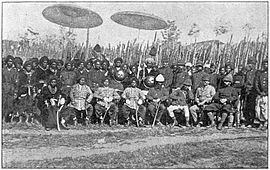
Back মণিপুর (দেশীয় রাজ্য) Bengali/Bangla Reino de Manipur Spanish Manipur (État princier) French मणिपुर राज्य Hindi Manipur (wilayah kerajaan) ID Manipur (stato) Italian 마니푸르 왕국 Korean ꯀꯪꯂꯩꯄꯥꯛ MNI Манипур (княжество) Russian மணிப்பூர் இராச்சியம் Tamil
Manipur Kingdom Meitei: Meetei Leipak | |||||||||||
|---|---|---|---|---|---|---|---|---|---|---|---|
| 1110–1949 | |||||||||||
 Manipur State in the Hicky's Bengal Gazette of 1907 | |||||||||||
| Capital | Imphal | ||||||||||
| Recognised national languages | Meitei language (officially known as Manipuri) | ||||||||||
| Religion |
| ||||||||||
| History | |||||||||||
• Foundation of the Kangleipak Kingdom | 1110 | ||||||||||
| 1824 | |||||||||||
• Princely state of India | 1891 | ||||||||||
• Accession to the Indian Union | 1947 | ||||||||||
• Merged into the Indian Union | 1949 | ||||||||||
| Area | |||||||||||
| 1941 | 22,372 km2 (8,638 sq mi) | ||||||||||
| Population | |||||||||||
• 1941 | 512,069 | ||||||||||
| |||||||||||
| Today part of | India Myanmar | ||||||||||





The Manipur Kingdom[1][2][3][4] was an ancient kingdom at the India–Burma frontier.[5][6][7] Historically, Manipur was an independent kingdom ruled by a Meitei dynasty.[8][9][10] But it was also invaded and ruled over by Burmese kingdom at various point of time.[11][12] It became a protectorate of the British East India Company from 1824, and a princely state of British Raj in 1891.[13] It bordered Assam Province in the west and British Burma in the east, and in the 20th century covered an area of 22,327 square kilometres (8,621 sq mi) and contained 467 villages.[citation needed] The capital of the state was Imphal.
- ^ Keen, Caroline (2015). An Imperial Crisis in British India. I.B. Tauris. p. 150-152. doi:10.5040/9780755624355. ISBN 978-1-78673-987-2.
Ghose maintained that under the Indian Penal Code only subjects of the Queen or foreigners residing in British India could be guilty of waging war against the Queen. Manipur was an independent sovereign state and..
- ^ Lloyd, Nick (2016). "Review of AN IMPERIAL CRISIS IN BRITISH INDIA: THE MANIPUR UPRISING OF 1891". Journal of the Society for Army Historical Research. 94 (380): 347–348. ISSN 0037-9700. JSTOR 44233143.
- ^ Sen (1992), p. 17
- ^ Andaya, Barbara Watson; Andaya, Leonard Y. (19 February 2015). A History of Early Modern Southeast Asia, 1400–1830. Cambridge University Press. p. 264. doi:10.1017/cbo9781139051323. ISBN 978-0-521-88992-6.
- ^ Somorjit, Wangam (1 March 2016). Manipur: The Forgotten Nation of Southeast Asia. Waba Publications & Advanced Research Consortium. ISBN 978-81-926687-2-7.
- ^ Fantz, Paul R.; Pradeep, S. V. (1995). Clitoria (Leguminosae) of South Eastern Asia.
- ^ https://press.uchicago.edu/books/HOC/HOC_V2_B2/HOC_VOLUME2_Book2_chapter18.pdf [bare URL PDF]
- ^ Arora, Vibha; Kipgen, Ngamjahao (2012). "The Politics of Identifying with and Distancing from Kuki Identity in Manipur". Sociological Bulletin. 61 (3): 429–449. doi:10.1177/0038022920120303. ISSN 0038-0229. JSTOR 26290634. S2CID 157167951.
Historically, Manipur was an independent kingdom ruled by Meitei dynasty. The physical boundary of Manipur has been fluctuating with historical changes in political power and the intra state and the inter state boundaries
- ^ Singha, Memchaton (2016). "Marriage Diplomacy Between the States of Manipur and Burma, 18th to 19th Centuries". Proceedings of the Indian History Congress. 77: 874–879. ISSN 2249-1937. JSTOR 26552717.
Both Manipur and Burma succeeded in maintaining their status as independent princely states until the British occupation by in the last part of 19th century
- ^ Waikhom, Rangitabali (2002). "Women's Society and Politics in Pre-Colonial Manipur". Proceedings of the Indian History Congress. 63: 1356–1357. ISSN 2249-1937. JSTOR 44158255.
- ^ Thant, Myint-U (2001), The Making of Modern Burma, Cambridge University Press, p. 15, ISBN 978-0-521-79914-0
- ^ Lieberman, Victor (1996). "POLITICAL CONSOLIDATION IN BURMA UNDER THE EARLY KONBAUNG DYNASTY 1752 – c. 1820". Journal of Asian History. 30 (2): 152–168. ISSN 0021-910X. JSTOR 41931038.
- ^ Chisholm, Hugh, ed. (1911). . Encyclopædia Britannica. Vol. 17 (11th ed.). Cambridge University Press. p. 582.
© MMXXIII Rich X Search. We shall prevail. All rights reserved. Rich X Search

